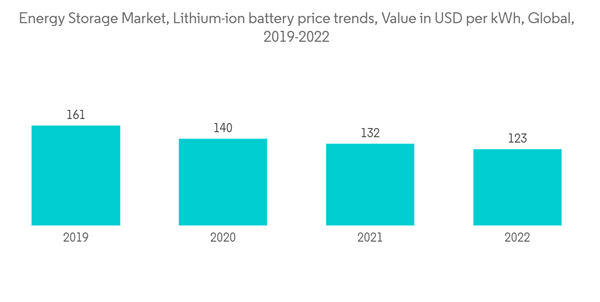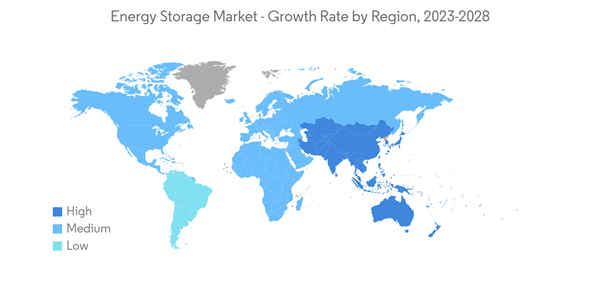The Energy Storage Market size is estimated at USD 51.10 billion in 2024, and is expected to reach USD 99.72 billion by 2029, growing at a CAGR of 14.31% during the forecast period (2024-2029).
The outbreak of COVID-19 had a negative effect on the market. Currently, the market has reached pre-pandemic levels.
This product will be delivered within 2 business days.
The outbreak of COVID-19 had a negative effect on the market. Currently, the market has reached pre-pandemic levels.
Key Highlights
- The development of the renewable energy sector, favorable government policies and programs for energy storage systems (ESS), and improved energy storage economics are all likely to have an impact on the energy storage market in the upcoming years.
- But a mismatch between the demand and supply of raw materials like cobalt, lithium, and graphite is likely to slow market growth over the next few years.
- The commercial and industrial (C&I) sector is using renewable energy sources like solar and wind power more and more to power their own buildings. But renewable energy isn't always a reliable source of power, and the C&I sector isn't making the most of these resources. So, the C&I sector is likely to use energy storage systems more and more to increase the amount of renewable energy it uses. This will create big opportunities for ESS providers in the future.
- Asia-Pacific was the largest market in the world in 2021. This was because countries like China, South Korea, and India needed more energy storage systems.
Energy Storage Market Trends
Batteries Segment to Dominate the Market
- Battery energy storage is a critical technology in transitioning to a sustainable energy system. The battery energy storage systems regulate voltage and frequency, reduce peak demand charges, integrate renewable sources, and provide a backup power supply. Batteries are crucial in energy storage systems and are responsible for around 60% of the system's total cost. However, batteries are expected to account for only a small portion of the total installed storage capacity.
- Various types of batteries used in energy storage systems are lithium-ion, lead-acid, nickel-metal hydride (NiMH), nickel-cadmium (NiCD), nickel-zinc (NiZn), and flow batteries, among others.
- Due to their declining prices, lithium-ion batteries are witnessing a massive demand in the battery energy storage market. The United States Department of Energy (DOE) announced an interim price target of USD 123/kWh by 2022, and the costs for lithium-ion batteries are estimated to fall to as low as USD 73/kWh by 2030. Lithium-ion batteries are also expected to hold the most significant share of the battery energy storage market. They require little maintenance, are lightweight, have a reliable cycle life, and have high energy density regarding the volume and high charge/discharge efficiency.
- Although most batteries in the energy storage market are lead-acid, other battery chemistries, such as lithium-ion (Li-ion), sodium, and flow batteries, are expected to provide additional benefits, such as increased durability or higher energy capacity for longer-term storage or other specific applications.
- Further, the battery energy storage systems use utility grids to supply electricity to consumers, which also reduces energy bills. Besides, the battery energy storage systems used in utilities are a cost-effective alternative to conventional infrastructure, especially in helping substations and transmission and distribution (T&D) lines to meet the increasing demand. These factors are contributing to the growth of the battery energy storage system market.
- Utilities are still the most significant segment of the battery energy storage market. More utilities include storage in their solicitations for solar projects, increasing the opportunities for battery energy storage systems during the forecast period.
- Furthermore, combining big batteries with renewable energy projects improves reliability without creating greenhouse gas (GHG) emissions. Therefore, homeowners and businesses increasingly focus on using batteries for backup power and capturing the excess energy from rooftop systems whenever required. So far, battery storage deployment has been concentrated in some developed economies in North America, East Asia-Pacific, Europe, and Central Asia.
- The increasing levels of renewable penetration and aging grid infrastructure are the major factors driving the growing deployment of battery energy storage in these regions.
- Therefore, the batteries segment is expected to dominate the energy storage market during the forecast period due to the above points.
Asia-Pacific to Dominate the Market
- Asia-Pacific is expected to keep leading the market for energy storage over the next few years. The region consists of two main types of power grids, each with different characteristics and opportunities for energy storage systems. On one side are highly developed countries like Japan, South Korea, New Zealand, and Australia, as well as other large cities with advanced grids that work well and use the latest technologies.
- On the other side, there are nations that are still developing fundamental infrastructure systems and have unreliable or limited power grids. Rapid population growth and urbanization are also happening quickly in the developing world, which is increasing the need for electricity.
- By 2027, India aims to have 275 GW of total wind and solar capacity, plus 72 GW of hydro and 15 GW of nuclear. Renewable energy's share of installed capacity is forecast to rise to 43% by 2027. With the growing renewable sector, the demand for energy storage systems to address the challenges related to intermittency in renewable power generation is expected to grow.
- Also, the 8th Basic Plan for Electricity Supply and Demand, which was released in 2017, said that the South Korean government expected electricity demand to grow by only 1% per year through 2030. The government wants to cut its greenhouse gas emissions and fine dust pollution by using ESS and other ways to save energy and using cleaner energy from renewable energy sources.
- Further, in 2021, China announced its plan to boost cumulatively installed non-pumped hydro energy storage to around 30 GW by 2025 and 100 GW by 2030, which, coupled with recent adoptions of time-of-use power tariffs that create a greater range between peak and off-peak power prices, are driving a boom in battery storage activity.
- India's plans to diversify its energy sources and provide electricity to everyone 24 hours a day, 7 days a week by adding a lot of renewable energy generation capacity could be a big driver for the market that was studied.During the forecast period, the market studied is also expected to be helped by the growing need for electricity, the rise in disposable income, and the need for a reliable power supply.
- By 2023, all existing homes and businesses in China will have to have a solar PV system installed on the roof.Under a government rule, a certain number of buildings will have to have solar PV systems installed.The government buildings (no fewer than 50%), the public structures (40%), the residential buildings (30%), and the rural buildings (20%) across about 676 counties will need to have solar PV rooftop systems.
- Due to these reasons, Asia-Pacific is expected to lead the market for energy storage over the next few years.
Energy Storage Industry Overview
The energy storage market is fragmented. The key players in this market market (in no particular order) include GS Yuasa Corporation, Contemporary Amperex Technology Co. Limited, UniEnergy Technologies, LLC, BYD Co. Ltd, and Clarios.Additional Benefits:
- The market estimate (ME) sheet in Excel format
- 3 months of analyst support
This product will be delivered within 2 business days.
Table of Contents
1 INTRODUCTION
4 MARKET OVERVIEW
5 MARKET SEGMENTATION
6 COMPETITIVE LANDSCAPE
Companies Mentioned (Partial List)
A selection of companies mentioned in this report includes, but is not limited to:
- GS Yuasa Corporation
- Contemporary Amperex Technology Co. Limited
- UniEnergy Technologies, LLC
- BYD Co. Ltd
- Clarios (Formerly Johnson Controls International PLC)
- LG Energy Solution Ltd.
- NGK Insulators Ltd.
- Samsung SDI Co. Ltd.
- Tesla Inc.
Methodology

LOADING...










